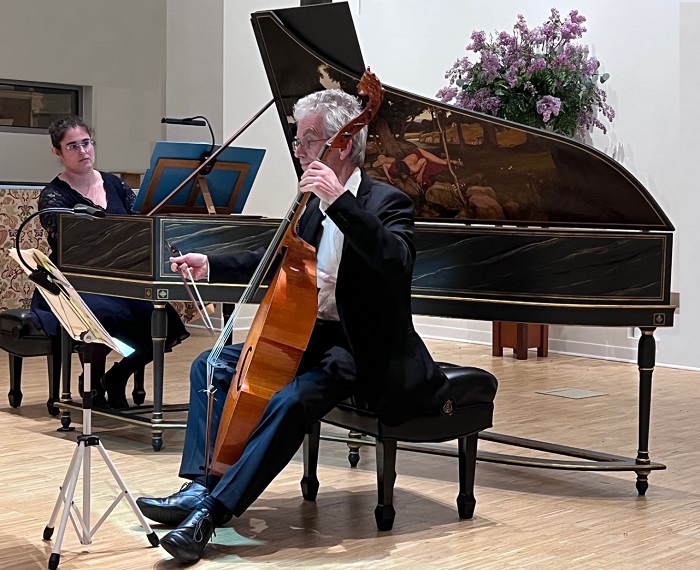Duo Gordis-Hantaï combine in stellar baroque recital for Capriccio series

Lillian Gordis and Jérôme Hantaï performed music for gamba and harpsichord Saturday night at St. Thomas’ Parish. Photo: Carolyn Winter/Capriccio Baroque
The three Hantaï brothers, who all specialize in early music instruments, were regular visitors to the Washington area over a decade ago. The viola da gamba player, Jérôme Hantaï, now a little greyer of hair, returned with his more recent recital partner, harpsichordist Lillian Gordis, for a diverting program. They performed duet pieces by J.S. Bach, Marin Marais, and François Couperin, presented Saturday evening by Capriccio Baroque at St. Thomas’ Parish in Dupont Circle.
The evening opened with music by the greatest composer for the viola da gamba, Marin Marais, a mixture of three selections each from two of his suites in G major, Suite No. 7 from his Pièces de Viole, Livre III, and Suite No. 4 from Livre II. The jaunty Allemande “La Magnifique” featured Marais’s written-out “Double” as the ornamented repeat of both sections of the dance. Gordis chose a lighter registration as an envelope of sound for the delicate viol.
Hantaï was at his most poignant in the gorgeous melody of the Sarabande “La désolée,” a velvety ribbon of sound that represented the viol at its most human, most vulnerable. The quicker Rondeau movement featured pleasing variations each time the main theme returned, with Gordis shadowing her partner with consummate measuring of rubato. The rich sound of the Sarabande Grave balanced out the crisp Gigue à l’angloise and Chaconne en Rondeau that concluded the set.
The slow Prelude of the Première Suite from Couperin’s Pièces de Viole evoked more of Hantaï’s most expressive playing, with vibrato added as ornamentation and skilfully tuned double-stops. A delicate Allemande and playful Courante followed, as well as another tender Sarabande. Couperin, a keyboard player, wrote less comfortably for the viol, perhaps related to some minor difficulties for Hantaï in the Gavotte and Gigue. The duo omitted the suite’s last movement, a substantial Passacaille en chaconne.
Gordis, who appeared in a solo recital with Capriccio Baroque last April, then offered a spirited rendition of Bach’s Partita No. 6 for harpsichord alone. The piece is not among those Gordis recorded on her second disc, devoted to the composer’s music, the focus of her studies during the coronavirus pandemic. Played on the presenter’s two-manual Colin Booth harpsichord, modeled on a 1710 instrument by J.C. Fleischer, it felt of a piece with that recording.
The partita opened with a virtuosic Toccata, played with a diverting variety of touch and rhythmic pacing. Free treatment of the more improvisatory outer sections contrasted with the solemn legato unspooling of the middle part’s fugal complexities. Gordis opted to omit the repeats in the ensuing dance movements, a decision that made sense given the duo’s choice to eschew an intermission after the Couperin.
Gordis even elided the melancholy Allemande and spritely, syncopated Courante, taking almost no pause between them, something she did between other movements as well. Having preferred the instrument’s softer registrations so far, she drew out a bolder sound for the Air, ornamenting the tragic Sarabande. Gordis handled the tuning of the instrument herself, and the lack of a tune-up at the midpoint of the evening began to show. The jaunty Gavotte led to the strangest Gigue in Bach’s works, a serious contrapuntal affair in quadruple meter.
The concert climaxed with Bach’s Sonata No. 3 for viola da gamba and harpsichord. Hantaï, who played all three of these sonatas with Maude Gratton in Washington in 2006, gave a masterful reading. The convivial first movement burgeoned with musical ideas, as Bach wove the gamba, an instrument that had largely fallen out of favor in his lifetime, in an equal partnership with the written-out harpsichord part. Hantaï again sang most movingly in the plangent slow movement, concluding on a lovely note that softened elegantly to silence. Both musicians sought to outdo one another in force and vivacity in the Finale, full of complex interplay.
It was back to France for the single encore, a swirling triple-meter dance by Antoine Forqueray. Titled “La Girouette,” it was an apt evocation of a whirlwind.
Harpsichordist Alberto Busettini performs music by Bernardo Pasquini, Alessandro Scarlatti, and Georg Friedrich Händel 7:30 p.m. May 27. capricciobaroque.org


